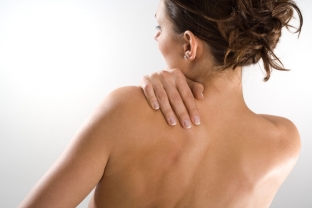Many people are unaware that the sternocleidomastoid muscle (SCSM) can cause pain. By itself, GCCM, located in the anterior lateral part of the neck, rarely disturbs the patient. However, it is she who can be responsible for the appearance of such unpleasant sensations as: headaches, pain and tension in the jaw area, dizziness, confusion, blurred vision, and even hearing loss. Massage of the sternocleidomastoid muscle, which estet-portal.com will talk about, will help get rid of such unpleasant symptoms.
Where is the sternocleidomastoid muscle located?
This two-part muscle originates at the base of the skull, behind the ear. The sternal part of the muscle is attached to the sternum, and the clavicular – to the collarbone. Since the sternocleidomastoid muscle is located directly under the skin, it can be seen with the naked eye by simply turning the head in any direction until it stops. GKSM can not only be seen, but also easily felt. As mentioned above, it is located in the neck assembly, closer to the front of it.
What problems can be caused by the sternocleidomastoid muscle.
Sternocleidomastoid symptoms
The sternal component of the muscle may be responsible for:
- pain in the cheek and trigeminal neuralgia located on the face;
- pain in the upper part of the sternum;
- pain in and above the eyes;
- red eye;
- lacrimation;
- drooping of the eyelid as a result of spasm of the orbicular muscle of the eye;
- eyelid twitch;
- blurred vision;
- double vision;
- pain in the throat and tongue, especially when swallowing;
- hearing impairment;
- pain in the back of the head and on top of the head.
The key part of the GCM can cause:
- pain in the forehead;
- pain in and behind the ear;
- pain in the cheek and molars;
- dizziness;
- pain in the ear;
- itching deep in the external auditory meatus;
- nausea (no vomiting);
- In rare cases, stretching a muscle can lead to fainting.
In addition to the above symptoms, the sternocleidomastoid muscle can also mimic sinus pain, leading to runny nose and other symptoms of sinusitis.
Massage of tragic points for pain in the neck and chest
Why do sternocleidomastoid problems occur
GKSM location "favorable" for the occurrence of any kind of overstrain, sprains and other stresses on this muscle, as a result of which the symptoms described above may appear. So, it is enough to sit all day, incorrectly bowing your head over the phone or slightly turning it to one side, – and pain is provided to you. Problems with GCM can be caused by the following:
- wrong posture (head constantly tilted forward);
- long stay in one position;
- shoulder holding the phone;
- sleep on stomach;
- weight lifting;
- falls and injuries;
- tight collar;
- scoliosis and other serious posture disorders;
- chronic cough or asthma.

Trigger point massage of the sternocleidomastoid muscle
Important! Do not massage the vessels passing near the sternocleidomastoid muscle! This can be avoided by squeezing the muscle itself rather than pressing it against the neck.
To massage the trigger points of the sternocleidomastoid muscles, do the following:
- Looking in the mirror, turn your head to the side – You will see the sternal portion of the GCCM.
- Grab the muscle between your thumb and the rest of your C-shaped fingers and look straight ahead.
- Looking forward, slightly tilt your head forward and towards the muscle you are massaging.
- Try to feel both components of the – their thickness roughly corresponds to the thickness of the index finger.
- Massage the muscle, starting from the middle, moving up towards the ear, and then down to the collarbone.
- If you hit a point that is causing pain, pinch it lightly, then reduce pressure until the pain subsides. Then slowly increase the pressure over 60-90 seconds.
This massage of the sternocleidomastoid muscle is recommended to be performed several times a day (3-6), gradually increasing the pressure. Listen to your feelings, try not to press too hard if you feel pain in the massaged points.






Add a comment